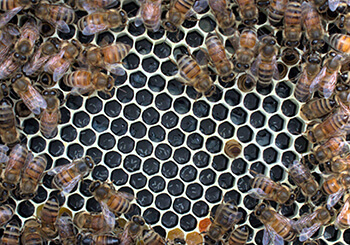
Laying worker bees surround cells filled with eggs
Laying worker hives can be frustrating. By understanding the biology of the situation, you might be able to take appropriate measures to fix the problem, or at least understand why it's such a hard problem to fix. Here, we explain what leads to laying worker bees and offer some solutions to reverse laying workers to get your hive queenright.
What are laying worker bees?
Queens and worker bees are all females, so they both have the ability to lay eggs — but because the brood produces pheromones that stop the workers’ ovaries from producing eggs, workers don’t typically lay eggs.
When the queen is gone, and there is no brood for about a month, these pheromones disappear. Without the brood pheromones, there is no inhibition of the workers’ ovaries, and one or more workers may start to lay eggs. The workers will not be mated, so they will only lay unfertilized eggs. Unlike unfertilized chicken eggs, which do not develop, unfertilized bee eggs develop into drones (male bees).
The hive cannot persist long with laying workers because they can’t produce more workers, only drones. This strategy has served the bees well for a very long time. In the wild, if a colony becomes queenless and has no new eggs or larvae to make into a new queen, the only way they can spread their genes is by making males and sending them out to look for unmated queens. Bees in managed hives don't know that a beekeeper may introduce new eggs or a new queen, so they don't have a good system to "turn off" worker laying once it starts. This is why beekeepers intervene after identifying a laying worker colony.
Identifying laying worker bees
You can recognize laying worker bees by watching for a few key indicators. Some of the signs of laying worker bees may also signify a new or weak queen, so examine the frames and cells to determine which is true.
Signs of laying worker bees include:
- Multiple eggs per cell
- Eggs laid off-center, in cell sides or walls
- Eggs laid on pollen
- Drone brood in worker cells
Process for fixing a laying worker hive
To fix a hive that has laying workers, there are a few options that may be successful. Simply adding a queen may fail as laying worker colonies often kill newly introduced queens. Instead, we have had luck with a two-step process to fix laying worker hives.
Provide frames of brood and introduce a queen
First, add a frame of brood from a queenright hive to the laying worker hive. That hive will now have some brood pheromone to help inhibit the laying worker ovaries. At the same time, introduce your new queen onto a split of a few frames of brood from a healthy hive. Give them a few days, then make sure the new queen is out and laying eggs.
You can join this nuc to the laying worker hive using the newspaper method. The brood installed a few days ago has provided pheromones to help stop the laying workers from laying, and by adding the nuc over a sheet of newspaper, the bees should accept the laying queen.
Shaking out the frames
Some beekeeping books recommend taking frames from a laying worker colony several hundred yards away from their stand and shaking all of the bees onto the ground, then moving all of the frames (without their bees) back to the original stand. The reasoning is that good workers will fly back to the hive, but the laying workers will be too heavy to do so. The books finish with the direction to then put a new queen in and the hive will be queenright.
This technique does not usually give good results. Some laying workers can fly back, and other laying workers will develop. There is not just one laying worker like there is one queen. The new queen you put in the hive is usually killed while in her cage and the laying workers continue laying drone eggs. Providing frames of brood and joining the colonies, as detailed above, is a more suitable option that offers better success.
Add the colony above another hive
Often, we might look at a hive with a laying worker and ponder if doing anything is advisable. Sometimes, we might want to cut our losses and just put the laying worker hive on top of another active hive. The laying workers shouldn't make their way down to the brood nest with the established queen, and will eventually die. The bees that are left in the laying worker hive will join the big hive underneath and all of these bees will protect the frames from wax moths. That might be as good an outcome as we can hope for with some hives.
These steps are a good place to start when it comes to fixing a laying worker colony. For more information and resources, enroll in our Beekeeping Classes and Events or explore our Beginning Beekeeper Guide.


